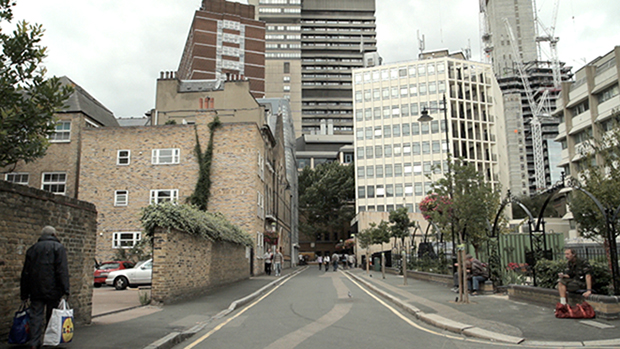Urban montage: Charlotte Ginsborg’s Melior Street
Charlotte Ginsborg’s Melior Street takes elements of documentary, performance and auteurship and stirs them together to produce an intriguing study of a place in perpetual flux.
The film was recently screened at Hackney Picturehouse, and was followed by a talk with the director and Emeritus Professor Ken Worpole, an expert in East London architecture and sociology.
Gaping like a canyon on the south side of London Bridge, the eponymous road – which has already changed significantly since the film’s original, pre-Shard release in 2011 – is composed of a ragtag mix of architecture.
Amongst towering glass facades, there’s a Catholic church, a homeless centre, a community garden, a banking college and an immigration office. From these locations, and others, Ginsborg pulls together a cast of real people and delivers a montage of varying experience and diverse psychologies.
Opening to a sequence of everyday urban images and a frantic strings accompaniment, the piece instantly calls to mind Dziga Vertov’s classic Man with a Movie Camera. Composer Gabriel Prokofiev, who heads a Hackney-based contemporary classical music label, has contributed a mesmerising score that perfectly complements Ginsborg’s artistry.
From then on, there’s a lot more to admire in the work. The photography is exquisite and the director’s creative approach to portraying a deeply fragmented – and fragmenting – social space is very impressive. As well exploring her chosen landscape using traditional documentary methods, she incorporates a series of odd, well-executed dramatic constructions and a bizarre use of song.
Taking her contributors’ words, Ginsborg pieces together tracks that are then performed by the characters; the film becomes at once a musical, a drama, a documentary and a topographical study. Such self-reflexive formal flourishes effectively – and provocatively – call into question the usefulness of drawing distinct lines between fiction and the real.
Beyond stylistic technique, the film is very much about discussion and sharing stories, in the tradition of Chaucer’s The Canterbury Tales – the procession in which, coincidentally, sets off from Southwark. The talk in the piece focuses a lot on community, belonging and identity.
While Ginsborg’s one-on-one interviews are always interesting and sometimes surprising, the conversations she facilitates between her characters can feel laboured, even cumbersome. Her concern with the authoring role of the director becomes, at times, a touch too pronounced and the dialogue suffers as a result.
But this small criticism mustn’t take away from the film’s considerable merit. Something of Melior Street feels like lifting the red rock of T.S. Eliot’s The Waste Land and peering into the shadows beneath. It’s a bold reflection of chaos, creativity and the transience of city life, and it’s well worth a watch for anyone interested in the psychogeography of London.

